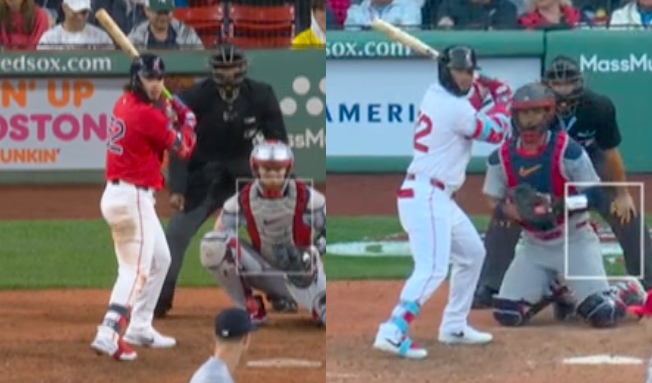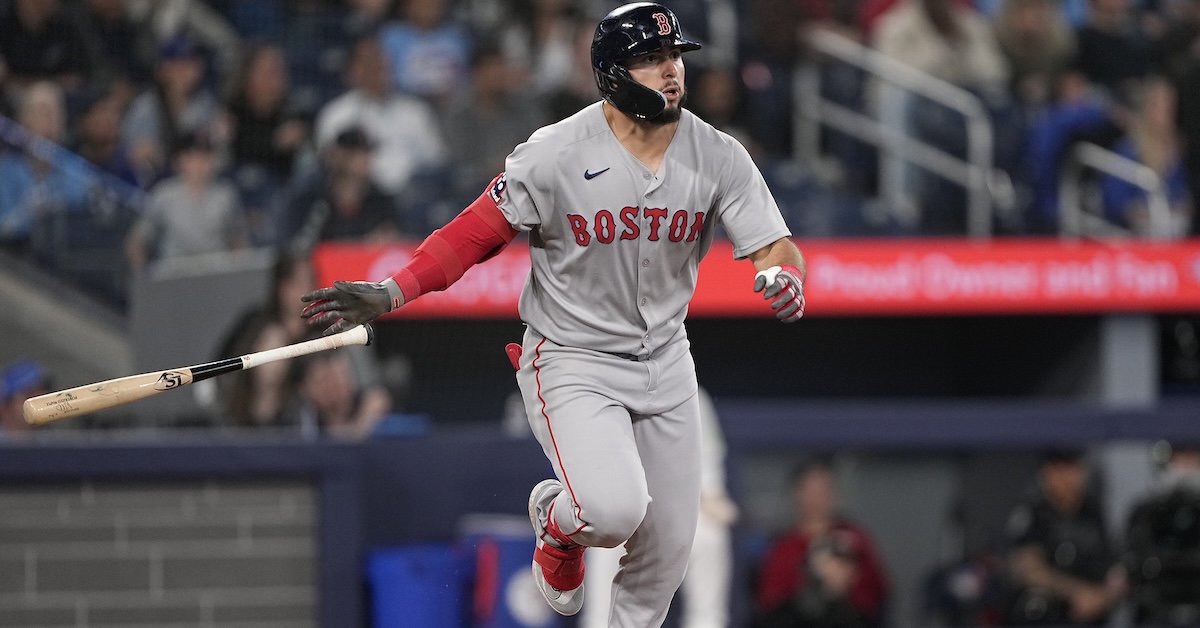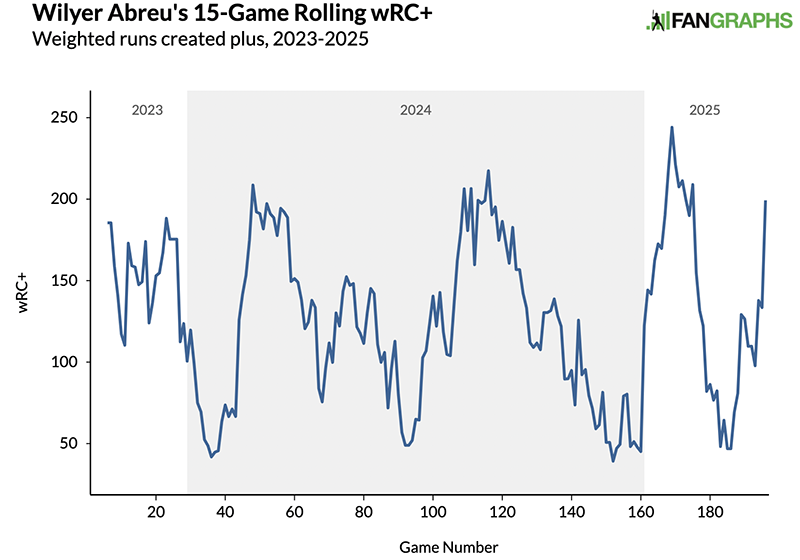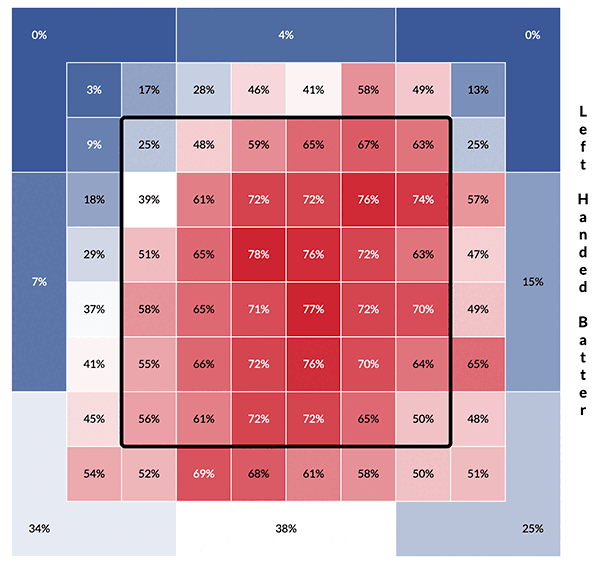I didn’t expect this from Wilyer Abreu. Don’t get me wrong. I love Abreu and I spent much of the offseason writing about him. I even developed a (literal) sliding scale to tabulate just how often and how intensely he dirtied his uniform. Abreu is a high-effort player who absolutely deserved the Rookie of the Year votes and Gold Glove he got last season. But I worried about him too. Abreu has done nothing but hit and play great defense since his 2023 debut, but he’s a lefty who’s been strictly platooned, and he only recently reached a full season’s worth of big league plate appearances. He seemed like a regression candidate, and that was before a gastrointestinal illness cost him a chunk of spring training and several pounds. The Red Sox weren’t even sure he’d be ready to start the season, but he was and he’s raked from day one. After this hot start, should we be all-in on Abreu?
First, I was worried a bit about Abreu’s defense. I didn’t expect him to turn into a pumpkin. He really was the best right fielder in baseball last season by pretty much any measure you can think of, and I expected him to remain great. Although he’s not a speedster, his instincts and effort have allowed him to make three three-star catches, two four-star catches, and one five-star catch this season. However, a ton of his value last year came from nine assists, and as I wrote in the Positional Power Rankings, that’s a volatile stat. You can’t just expect someone to rack up assists year after year, if for no other reason than the fact that word gets out about a rocket arm like Abreu’s. Those gaudy out totals would turn into smaller credits for keeping runners from taking extra bases. Or so I thought.
Abreu has already tallied three assists, including the one above, which is about as perfect a throw as you’ll ever see. Overall, he ranks in the top five among right fielders in DRS, OAA, and FRV. I needn’t have worried about the defense.
The offense is the big question, though. Abreu put up a 135 wRC+ over a 28-game cup of coffee in 2023. He followed it up with a 114 wRC+ in his full-season debut, and he’s now up to 167. He’s never not hit, and now he’s hitting better than ever. How much should we trust his early-season stats?
Let’s start with the bad news. Abreu is still being strictly platooned. Earlier this year, I wondered whether his excellent overall showing in 2024 might earn him a real shot at being an everyday player rather than a platoon player. He ran just a 48 wRC+ in his limited sample against lefties last season, but his excellence with the glove and on the bases could offset that some, and because the Red Sox are bursting with exciting young outfielders, requiring a platoon partner is a bit of a drag on the roster. However, Abreu is being platooned even more tightly this season. After facing lefties just 15% of the time in 2024, he’s down to 12% so far this season. Abreu has just 17 PAs against lefties in 2025, far too little to glean any meaningful information, but for what it’s worth, he has run much better chase, whiff, walk, and strikeout rates in that small sample.
OK. Defense is out of the way. Platoon concerns are out of the way. Now we get to talk about the fun stuff. Ready? Here we go.
Abreu is raking! Last year, he ran a .336 wOBA off a .317 xwOBA. He seemed like maybe he was getting a hair lucky. This season, he’s got a .416 wOBA and a .426 xwOBA. His BABIP is almost identical to last season’s. He’s no longer getting lucky. He’s just hitting way better. His 1.8 WAR ranks 12th among position players, and his 167 wRC+ means he’s the eighth-best qualified hitter in the game. I had been waiting to write this article until Abreu had his first slump of the season. I didn’t want to jump on the bandwagon too soon. But that slump has come and gone. It turned out to be short and Abreu has gone right back to mashing.
It’s still early. This is still just a hot start. But seeing that blue line climb right back up into the 200s is a very encouraging sign.
It’s time to look under the hood to see what Abreu is doing differently this season. The topline stats tell us very clearly where to look. Abreu is striking out way less, walking way more, and slugging a ton.
Walks, Strikeouts and Slug
| Season | BB% | K% | ISO |
|---|---|---|---|
| 2023 | 10.6 | 27.1 | .158 |
| 2024 | 8.9 | 28.0 | .206 |
| 2025 | 15.0 | 21.4 | .286 |
With such huge changes in walk and strikeout rates, we’d expect to see that Abreu is being much more selective at the plate, and his chase rate is indeed way down. Abreu swung at 28% of pitches outside the zone last season, but he’s down at 23% this season. Meanwhile, his swing rate inside the zone has climbed 10 percentage points, from 68% to 78%. I didn’t label the GIF below, because the difference is easy to see. What’s blue and white and no longer red all over? Wilyer Abreu’s 2025 swing heat map.
It’s the one with the red concentrated in the heart of the plate. Abreu is much more aggressive there and much, much less aggressive below the strike zone and on the inside corner. He is making more contact and doing more damage a bit higher in the zone than he did last season. There’s a reason for that particular pattern. Abreu has been much more choosy when it comes to soft stuff. He’s got a five-point drop in his chase rate overall, but against breaking and offspeed pitches, that drop is nearly 16 points.

Abreu is recognizing and spitting on soft stuff like never before, but he’s more aggressive against fastballs and pitches inside the zone. That doesn’t sound particularly fluky. That just sounds like someone who’s improved his pitch recognition. In fact, it looks like his whole approach has changed, which is surprising.
Abreu told reporters before the season, “Last year was a great year, so in terms of the way I prepare, I just wanted to keep everything the exact same. I got really good results, so I’m not changing anything.” But take a look at the screenshots below. The 2024 batting stance on the left looks very different from the 2025 stance on the right.

According to Baseball America, the Red Sox asked Abreu to close his stance some when they got him from the Astros in the 2022 Christian Vázquez trade. However, Abreu definitely has a new, much more open stance this year. His torso is not quite so vertical, but it’s still closed off. Only his lower half has opened up. Last year, his front foot was turned aggressively inward like Juan Soto’s, but this season, it’s roughly perpendicular to the pitcher. He’s also ditched his leg kick in favor of a toe tap. That’s a lot of changes for someone who didn’t plan on making any. But it’s not just how he looks. Abreu’s approach is also affecting his contact quality. It’s time to dive into that .298 ISO.
After hitting 15 homers in 2024, Abreu already has nine. He’s in the top 10 in homers, slugging, and isolated slugging. But here’s the thing. His contact quality is almost exactly the same as it was last year. His 90th percentile exit velocity is up a little, but his average exit velocity and hard-hit rate are nearly identical. His bat speed is down a tick, and if you only look at pitches inside the strike zone, his exit velocity is lower, too.
Abreu has come by all that extra power by lifting the ball much more often. His groundball rate has fallen from 34% to 27%. This season, 25% of his batted balls have been pulled in the air, up from 22% last year. Not only that, but when Abreu does pull the ball in the air, he’s added nearly 2 mph of exit velocity and just over seven percentage points of hard-hit rate from 2024. On other kinds of balls, his exit velocity is down. To be clear, because he hits the ball so hard, Abreu doesn’t necessarily have to pull the ball in the air to be successful. A 91.5-mph average exit velocity and 50.6% hard-hit rate will play in all parts of the ballpark. That’s doubly true at Fenway Park, where lefties always have the chance to dump the ball off the Green Monster for a double. Abreu did that five times last year, but he’s only hit one ball off the Monster so far this year.
We’re still dealing with a small sample size. Abreu has put just 89 balls in play this season. His edge rate – the percentage of pitches on the edges of the strike zone – is among the lowest in baseball. That’s a fluky stat that can make his swing decisions look better than they really are. It’s probably related to the fact that his contact rate inside the zone has gone way up while his contact rate outside the zone is way down. That’s usually unsustainable, and it can disguise a few flaws. Still, Abreu certainly looks different at the plate. He’s got a new stance, he’s laying off soft stuff, he’s focused on pitches up over the middle of the plate, and he’s getting to his power when he pulls the ball in the air. These sound like genuine approach changes. His edge rate and contact rates will likely balance out some, and when they do, they’ll increase his whiff rate and bring down his contact quality numbers. But even after that happens, this profile will offer a lot to be excited about going forward.
Content Source: blogs.fangraphs.com



